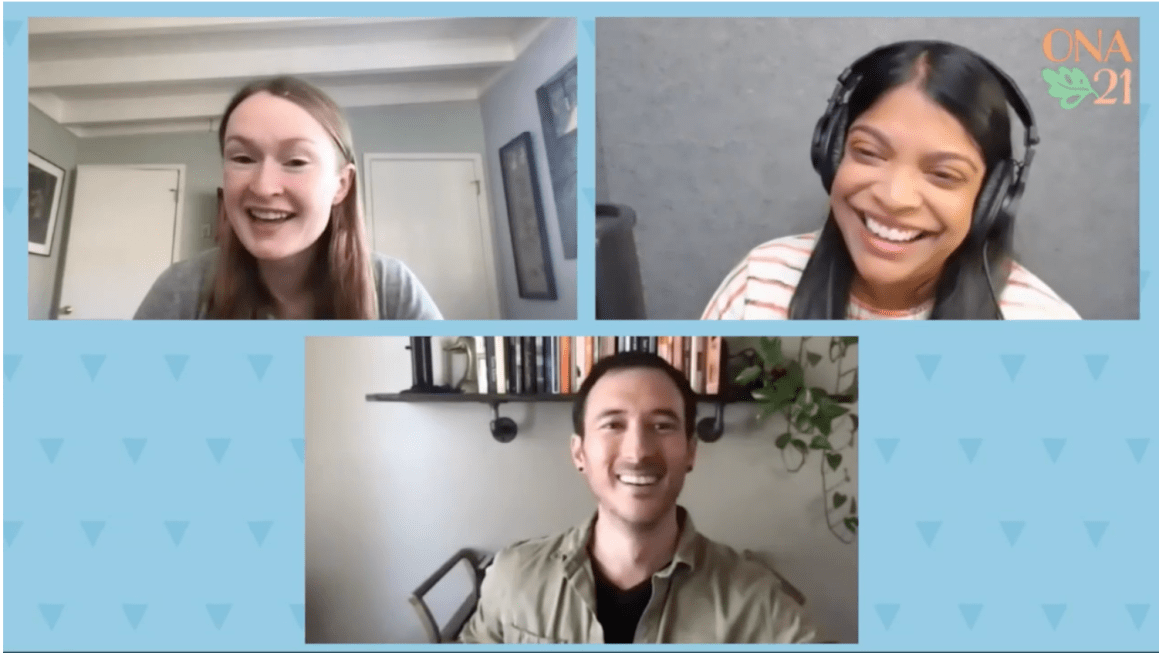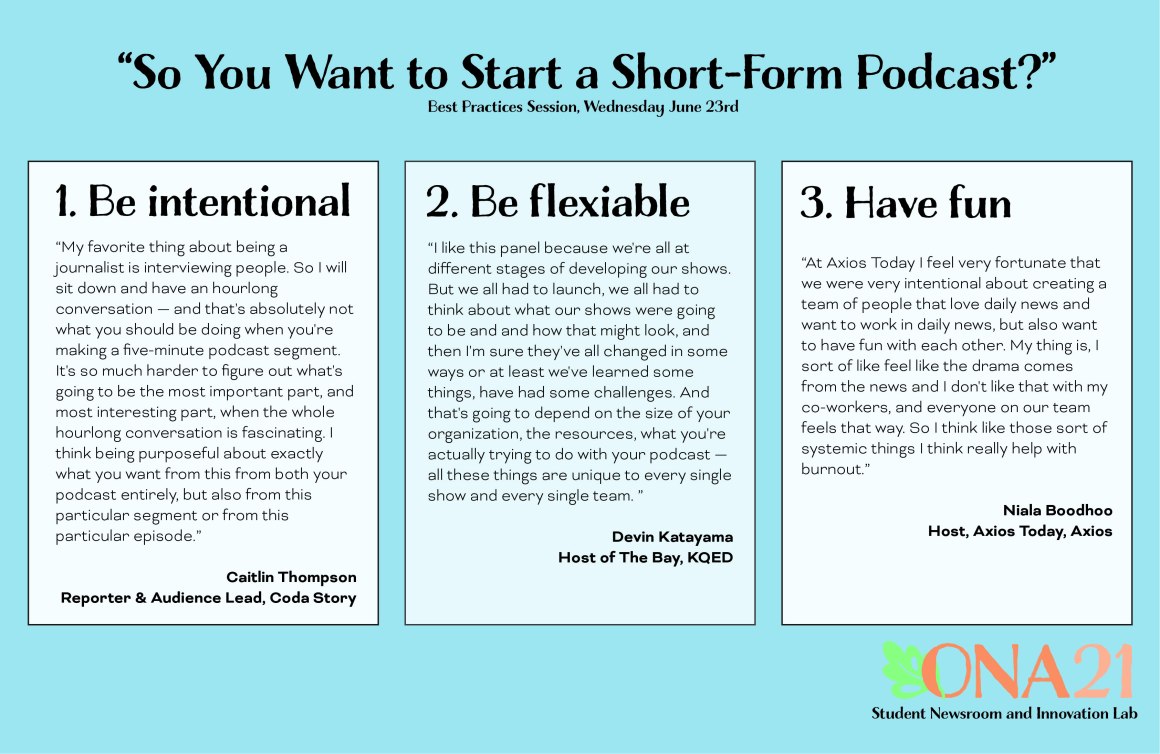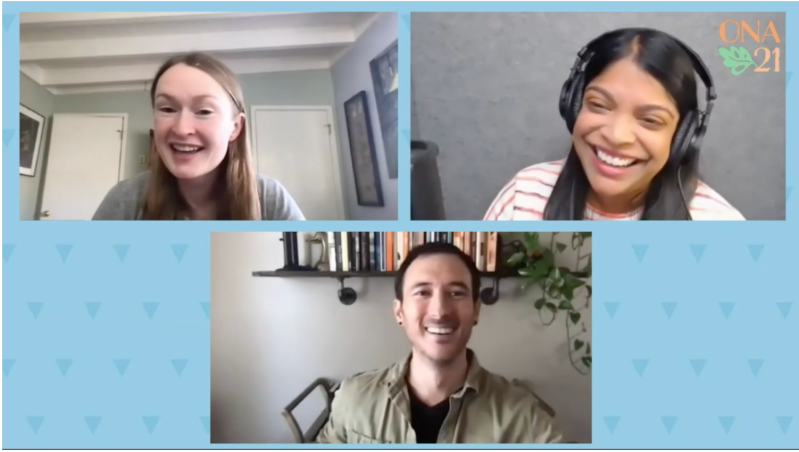Podcast enthusiasts were brewing with excitement in the chat room before the best practices session “So, You want to Start a Short-Form podcast?” even began during the ONA21 conference. As the clock counted down to the start of the session, an attendee asked who else was excited to hear these hosts speak.
This session felt and sounded like a podcast episode, but the speakers just have that voice. They sounded calm, modulated and were booming with excitement to share their passion for short-form podcasting.
Caitlin Thompson, reporter & audience lead at Coda Story; Niala Boodhoo, host of Axios Today; and Devin Katayama, host of The Bay, led this conversation about making a successful switch to audio in the newsroom.
Thompson, Boodhoo and Katayama introduced themselves and their shows. Each show has a unique objective, reporting style, publishing frequency and team structure.

Having a clear objective and voice was their first tip for attendees. They all agreed that this was the first step in developing a short-form podcast.
At the beginning of the session, they shared a rundown of what they would discuss and encouraged those who want to start a podcast to do the same to stay organized.
Short-form podcasts are hard. “In the public radio world 15 minutes, which is roughly what our podcast is, is actually a lot of space. But we’re doing it so quickly, and we’re putting a lot of creativity into it,” said Katayama, host of The Bay. His podcast recently celebrated its third anniversary and 500th episode.
The Bay is aired three days a week through KQED, a public radio station in San Francisco. Their stories are “second day” or “of the week” headlines that the community wants to know more about.
Although short is hard, being very intentional about your purpose and having a mission is essential. When recording, Boodhoo, of Axios Today, acts as if it is a live recording.
“We found [that] preserves the narrative of it sounding like a really tight, live conversation,” said Boodhoo, who later added how this helps her producers.
She said that 90% of the work happens before you’re at the mic.
“I think doing all that work on the front end actually makes things a lot smoother afterwards for the kind of work that we’re doing because we’re mostly doing two-way conversations,” she said.
“I think the biggest thing is to know before you launch, roughly, where you need to go and then be perfectly OK with having to shift,” said Thompson of Coda Story.
Thompson and her small team at Coda launched its podcast at the beginning of 2021. In the last few weeks, they’ve had to adjust their structure to match the team’s work capacity.
Having to constantly adjust and adapt, whether it be because of a pandemic or to avoid burnout, adds another challenge to short-form podcasting.
Suppose you are thinking of implementing podcasts into your newsroom or independently. In that case, you cannot find your voice until you start recording, says Boodhoo.
“I think that’s a really important thing: Know that you have to start doing it.” said Boodhoo,” Be willing to evolve and be flexible about how you are creating your sound. Another really important part of this is the host voice, right?”
Thompson, Boodhoo, and Katayama all have a distinct voice – literally and figuratively.
At Coda, “we’re going for a very personal conversation. It’s something that grabs you and really pulls you in because it feels like you’re in the room with the person.”
“Unlike maybe some other programs in KQED, we really get to choose whatever we want,” said Katayama. “Working with a small team of three, we get to be really creative and push each other to be like — what would be cool that’s not out there right now.”
At Axios Boodhoo is, “very fortunate that we’re not, for example, we’re not like the AP or NPR. We’re not a news organization of record, where we have to sort of catalogue everything that happened.” Her team is able to pick what they think is the most interesting.
“That’s what I always say about Axios Today is that you’re maybe not going to get the latest news, and it may not be, to, like, what other people think is the most comprehensive set of news but you are going to hear things that we think are interesting in our newsroom.”
Stephanie Siek, a journalist who attended this best practices session, said she was considering developing an accompanying podcast for an article she wrote about Tina Bell, “the godmother” of grunge.
Seik said she would love to create a three to four episode arc, each focusing on a different aspect of Tina Bell’s life, before, during and after time with the band Bam Bam.
If her idea were to come to fruition, Siek believes that “it would be great to have it distributed either as a supplement to the print story, which someone in the session suggested or maybe as a kind of ‘guest hosting’ thing on an established podcast.”
Siek has a foundation for a series of podcasts but said she learned that she has a lot more work to do before her idea is ready for other ears.
“I really appreciated what the presenters said about the importance of having a clear vision of what you’ll talk about and about what you want your audience to get out of the podcast.”
This session, “made me a little more confident about whether my idea for a short-term podcast is viable,” Siek said.
Starting a successful podcast begins with knowing who you are and what you want to say. This panelists concluded the session with this idea and how the elements they shared led them to success.
“Success was actually making it work on a logistical level,” said Katayama.
This session at ONA21 showed attendees what short-form podcasts can do. Tools like Anchor and Soundtrap by Spotify make it easier to execute your logistical ideas. All you have to do is start recording.







You must be logged in to post a comment.